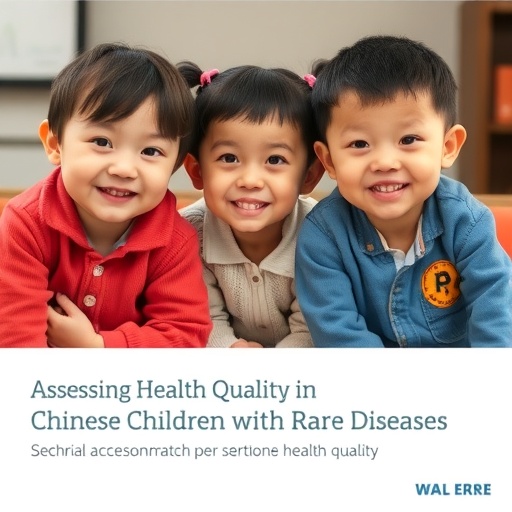In recent years, the conversation surrounding health-related quality of life (HRQoL) has become increasingly significant, particularly with regard to vulnerable populations such as children diagnosed with rare diseases. A groundbreaking nationwide study conducted in China reveals critical insights into the health-related quality of life experienced by these children, an often overlooked demographic. This study marks a pivotal moment in our understanding of the interplay between rare diseases and the overall well-being of affected children, urging both medical professionals and policymakers to acknowledge and address the unique challenges posed by these conditions.
The prevalence of rare diseases is estimated to affect approximately 7-8% of the global population. In China, the implications of such conditions are profound, influencing not only the health of individuals but also the socio-economic conditions and emotional well-being of entire families. The research conducted by Yu, Zhang, and Chen aims to illuminate the often hidden struggles faced by children living with uncommon ailments, paving the way for future enhancements in healthcare delivery and support systems.
One of the most compelling findings of this study is the substantial impact that rare diseases have on the everyday lives of children. Parents and guardians often report higher levels of stress, anxiety, and depression when raising a child with a rare condition. These emotional ramifications extend beyond the individual and ripple through family dynamics, leading to a need for comprehensive support strategies that address both the medical and psychological aspects of these conditions.
The methodology employed in this study was robust, employing a cross-sectional design to gather data from a wide range of participants across various provinces in China. Utilizing validated tools such as the PedsQL™ 4.0 Generic Core Scales, the researchers quantified HRQoL to analyze the results methodically. In doing so, it became possible to establish a clear relationship between specific rare diseases and the impairment they cause in children’s everyday functioning, effectively bringing to light the urgency for specialized care.
Further analysis showed that the effects of socio-economic status cannot be ignored in this context. Children from lower-income families were found to experience significantly lower levels of HRQoL compared to their peers. This socioeconomic disparity highlights the intersectionality of health and wealth, where financial constraints limit access to essential healthcare services and resources that could otherwise enhance the quality of life for these children.
Moreover, the study addresses the stigma surrounding rare diseases, which can further exacerbate the challenges faced by both children and their families. Many families experience social isolation stemming from a lack of understanding and awareness of these conditions in broader society. This societal stigma not only affects the mental well-being of children but also hinders their opportunities for social interaction, ultimately leading to decreased quality of life.
The implications of this research extend beyond the individual level and raise critical questions for policymakers. As the data illustrates the profound effects of rare diseases on children’s lives, there emerges an urgent call for increased investment in healthcare services specifically tailored to meet the needs of this demographic. Policymakers are urged to recognize the importance of improved healthcare access, funding for research, and initiatives aimed at raising public awareness about rare conditions.
As we look to the future, the importance of integrating patient perspectives into healthcare policy cannot be overstated. This study emphasizes the need for platforms that allow families of children with rare diseases to voice their experiences and needs, ultimately aiding in the development of targeted interventions to improve HRQoL. Collaboration between medical professionals, research institutions, and advocacy groups will be instrumental in fostering an environment where the unique challenges faced by these children can be effectively addressed.
In conclusion, the study by Yu, Zhang, and Chen serves as a clarion call for increased awareness and actions focused on the health-related quality of life among children living with rare diseases in China. As healthcare systems adapt to the complexities posed by these unique medical challenges, it is imperative to prioritize comprehensive care that encompasses the physical, emotional, and social dimensions of health. By doing so, society can ensure that every child, regardless of their medical circumstances, has the opportunity to lead a fulfilling life.
In drawing attention to the health-related quality of life among children with rare diseases, this research not only fills a critical knowledge gap but also lays the groundwork for future studies that could further explore and expand upon these findings. As the conversation continues, the hope is to create a more supportive framework for families navigating the intricacies of rare health conditions, ultimately fostering a more compassionate and informed society.
The implications of this pivotal study stretch beyond the borders of China, as many nations grapple with similar issues concerning rare diseases and their impacts on children. Global collaboration in research, resource sharing, and policy development could significantly improve outcomes, providing a roadmap towards better care and quality of life.
By shining a light on the pervasive challenges and emotional burdens faced by children with rare conditions, the findings empower families and healthcare professionals alike to advocate for meaningful changes that prioritize the well-being of these often-overlooked individuals. Therefore, the research stands as a transformative step in addressing the broader implications of rare diseases, heralding a new wave of understanding and support that seeks to enhance the quality of life for vulnerable children worldwide.
Subject of Research: Health-related Quality of Life among Children Living with Rare Diseases in China
Article Title: Health-related Quality of Life among Children Living with Rare Diseases in China: a Nationwide Study
Article References: Yu, J., Zhang, H., Chen, S. et al. Health-related Quality of Life among Children Living with Rare Diseases in China: a Nationwide Study. Applied Research Quality Life (2025). https://doi.org/10.1007/s11482-025-10510-5
Image Credits: AI Generated
DOI: https://doi.org/10.1007/s11482-025-10510-5
Keywords: Health-related quality of life, children, rare diseases, China, socioeconomic disparities, policy implications, healthcare access, patient perspectives, stigma, family dynamics.




